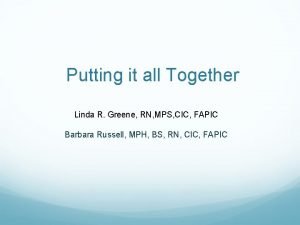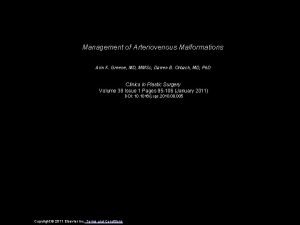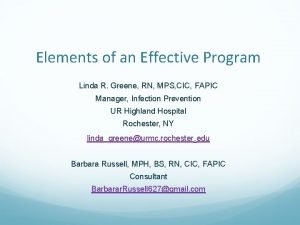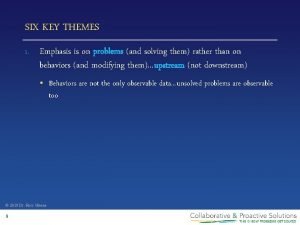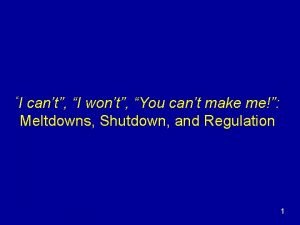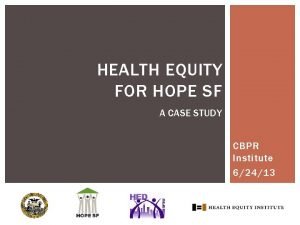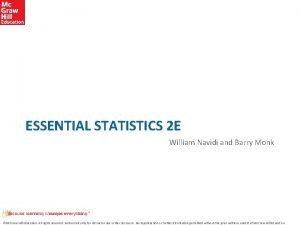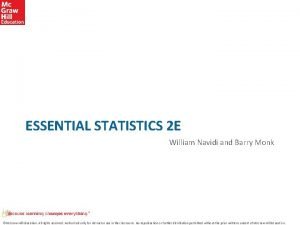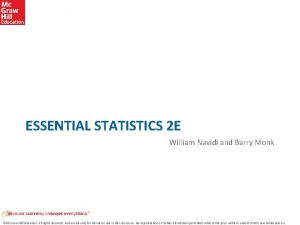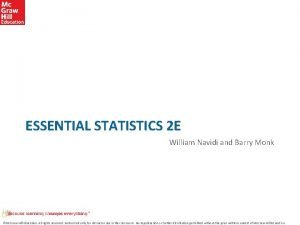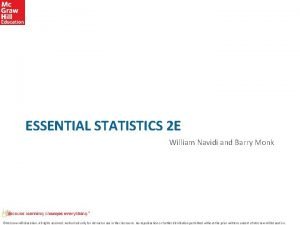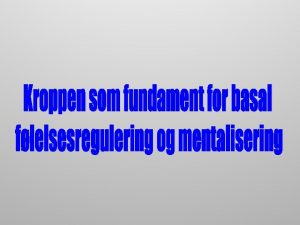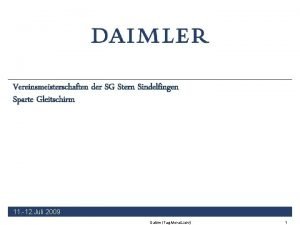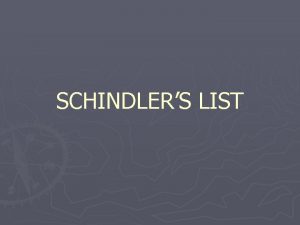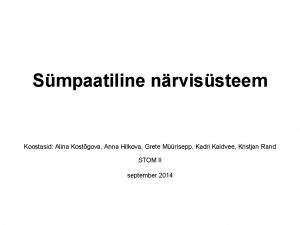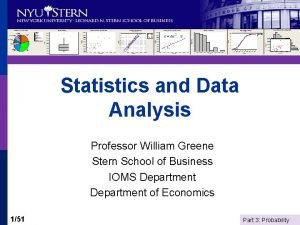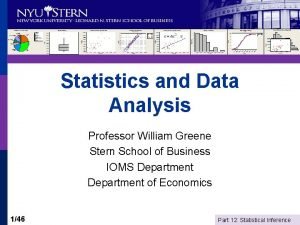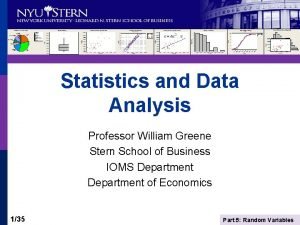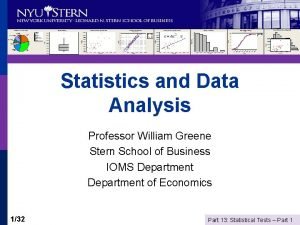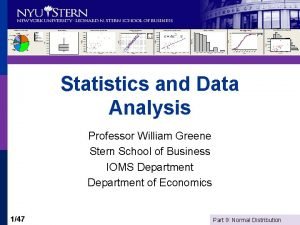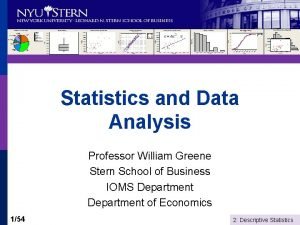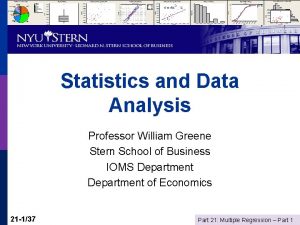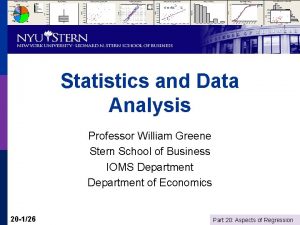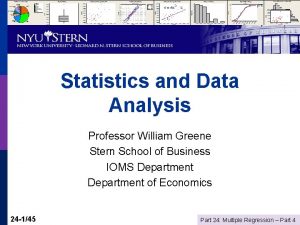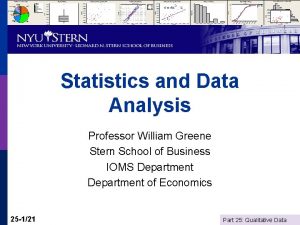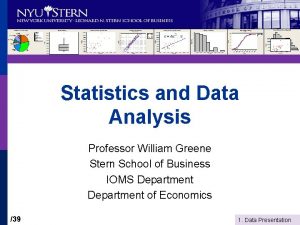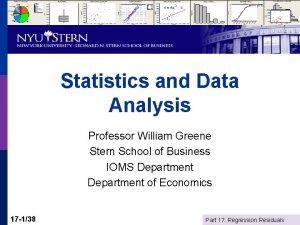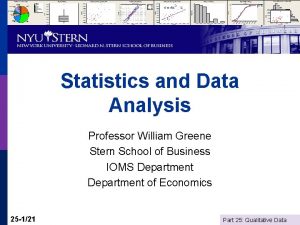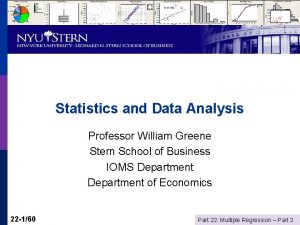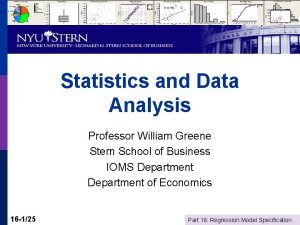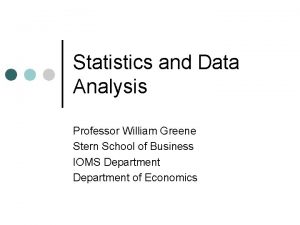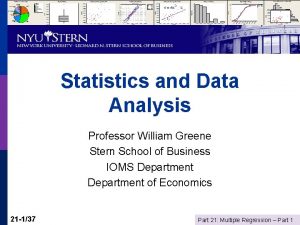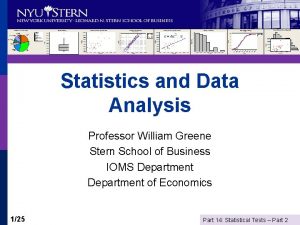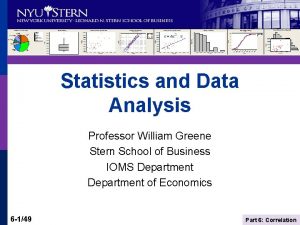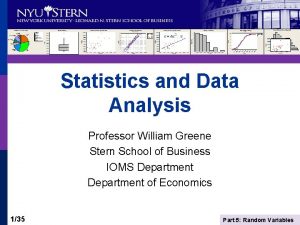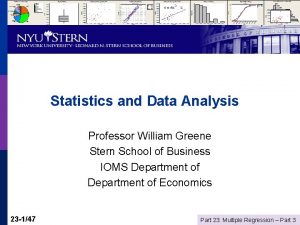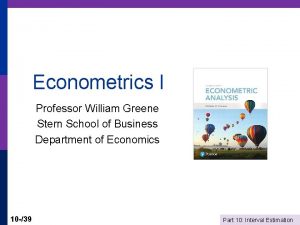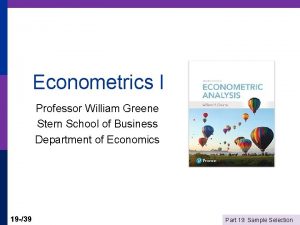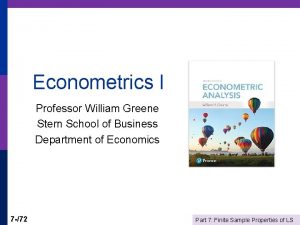Statistics and Data Analysis Professor William Greene Stern














































- Slides: 46

Statistics and Data Analysis Professor William Greene Stern School of Business IOMS Department of Economics 16 -1/46 Part 16: Linear Regression

Statistics and Data Analysis Part 16 – Regression 16 -2/46 Part 16: Linear Regression

16 -3/46 Part 16: Linear Regression

A Regression Analysis that People Really Cared About The Year 2000 World Health Report by WHO http: //www. who. int/whr/2000/en 16 -4/46 Part 16: Linear Regression

Health Care System Performance 16 -5/46 5 Part 16: Linear Regression

New York Times, Page 1, June 21, 2000 16 -6/46 Part 16: Linear Regression

16 -7/46 Part 16: Linear Regression

That Number 37 Ranking p What is the source? p What is it? Ranking of what? p And why are we looking at it in our class on Statistics and Data Analysis? n Interesting n It’s an application of regression analysis. 16 -8/46 Part 16: Linear Regression

The Source Behind the News http: //www. who. int/entity/healthinfo/paper 30. pdf 16 -9/46 Part 16: Linear Regression

What Did They Study? 16 -10/46 Part 16: Linear Regression

The standard measure of health care success is Disability Adjusted Life Expectancy, DALE 16 -11/46 Part 16: Linear Regression

The WHO Researchers Were Interested in a Broader Measure These are the items listed in the NYT editorial. 16 -12/46 Part 16: Linear Regression

They Created a Measure COMP = Composite Index “In order to assess overall efficiency, the first step was to combine the individual attainments on all five goals of the health system into a single number, which we call the composite index. The composite index is a weighted average of the five component goals specified above. First, country attainment on all five indicators (i. e. , health inequality, responsiveness-level, responsiveness-distribution, and fair-financing) were rescaled restricting them to the [0, 1] interval. Then the following weights were used to construct the overall composite measure: 25% for health (DALE), 25% for health inequality, 12. 5% for the level of responsiveness, 12. 5% for the distribution of responsiveness, and 25% for fairness in financing. These weights are based on a survey carried out by WHO to elicit stated preferences of individuals in their relative valuations of the goals of the health system. ” (From the WHO Technical Report) 16 -13/46 Part 16: Linear Regression

Did They Rank Countries by COMP? Yes, but that was not what produced the number 37 ranking! 16 -14/46 Part 16: Linear Regression

So, What is Going On? p A Model: Health Care Output = a function of Health Care Inputs p OUTPUT = COMP p INPUTS = Health Care Spending and Education of the Population 16 -15/46 Part 16: Linear Regression

The WHO COMP Equation 16 -16/46 Part 16: Linear Regression

Estimated Model β 1 β 2 β 3 α 16 -17/46 Part 16: Linear Regression

The Best a Country Could Do vs. What They Actually Do 16 -18/46 Part 16: Linear Regression

16 -19/46 19 Part 16: Linear Regression

The US Ranked 37 th! Countries were ranked by overall efficiency 16 -20/46 Part 16: Linear Regression

Linear Regression p p p 16 -21/46 Correlation (and vs. causality) Examining correlation n Descriptive: Relationship between variables n Predictive: Use values of one variable to predict another. n Control: Should a firm increase R&D? n Understanding: What is the elasticity of demand for our product? (Should we raise our price? ) The regression relationship Part 16: Linear Regression

Positive Correlation and Regression Expected Number of Real Estate Cases Given Number of Financial Cases 2. 4 2. 3 2. 2 The “regression of R on F” 2. 1 2. 0 1. 9 0 1 2 Financial Cases 16 -22/46 Part 16: Linear Regression

Correlation of Home Prices with Other Factors What explains the pattern? Is the distribution of average listing prices random? 16 -23/46 Part 16: Linear Regression

16 -24/46 Part 16: Linear Regression

16 -25/46 Part 16: Linear Regression

Regression Modeling and understanding correlation p “Change in y” is associated with “change in x” p n n n How do we know this? What can we infer from the observation? Causality and correlation http: //en. wikipedia. org/wiki/Causality and see, esp. “Probabilistic Causation” about halfway down the article. 16 -26/46 Part 16: Linear Regression

Correlation – Education and Life Expectancy Graph Scatterplots With Groups/ Categorical variable is OECD. Causality? Correlation? Does more education make people live longer? A hidden driver of both? (GDPC) 16 -27/46 Part 16: Linear Regression

Useful Description(? ) Scatter plot of box office revenues vs. number of “Can’t Wait To See It” votes on Fandango for 62 movies. What do we learn from the figure? Is the “relationship” convincing? Valid? (Real? ) 16 -28/46 Part 16: Linear Regression

More Movie Madness Did domestic box office success help to predict foreign box office success? Movies. mtp Note the influence of an outlier. 500 biggest movies up to 2003 16 -29/46 499 biggest movies up to 2003 Part 16: Linear Regression

Average Box Office by Internet Buzz Index = Average Box Office for Buzz in Interval 16 -30/46 Part 16: Linear Regression

Correlation 16 -31/46 p Is there a conditional expectation? p The data suggest that the average of Box Office increases as Buzz increases. p Average Box Office = f(Buzz) is the “Regression of Box Office on Buzz” Part 16: Linear Regression

Is There Really a Relationship? Box. Office is obviously not equal to f(Buzz) for some function. But, they do appear to be “related, ” perhaps statistically – that is, stochastically. There is a correlation. The linear regression summarizes it. A predictor would be Box Office = a + b Buzz. Is b really > 0? What would be implied by b > 0? 16 -32/46 Part 16: Linear Regression

Using Regression to Predict Stat Regression Fitted Line Plot Options: Display Prediction Interval The equation would not predict Titanic. Predictor: Overseas = a + b Domestic. The prediction will not be perfect. We construct a range of “uncertainty. ” 16 -33/46 Part 16: Linear Regression

Effect of an Outlier is to Twist the Regression Line With Titanic, slope = 1. 051 Without Titanic, slope = 0. 9202 16 -34/46 Part 16: Linear Regression

Least Squares Regression 16 -35/46 Part 16: Linear Regression

How to compute the y intercept, a, and the slope, b, in y = a + bx. b a 16 -36/46 Part 16: Linear Regression

Fitting a Line to a Set of Points Gauss’s method of least squares. Choose a and b to minimize the sum of squared residuals Yi Residuals Predictions a + bxi Xi 16 -37/46 Part 16: Linear Regression

Computing the Least Squares Parameters a and b 16 -38/46 Part 16: Linear Regression

Least Squares Uses Calculus 16 -39/46 Part 16: Linear Regression

b Measures Covariation b is related to the correlation of x and y. Predictor Box Office = a + b Buzz. 16 -40/46 Part 16: Linear Regression

Is There Really a Statistically Valid Relationship? We reframe the question. If b = 0, then there is no (linear) relationship. How can we find out if the regression relationship is just a fluke due to a particular observed set of points? To be studied later in the course. Box. Office = a + b Cntwait 3. Is b really > 0? 16 -41/46 Part 16: Linear Regression

Interpreting the Function b a a = the life expectancy associated with 0 years of education. No country has 0 average years of education. The regression only applies in the range of experience. b = the increase in life expectancy associated with each additional year of average education. The range of experience (education) 16 -42/46 Part 16: Linear Regression

Correlation and Causality Does more education make you live longer (on average)? 16 -43/46 Part 16: Linear Regression

Causality? Correlation = 0. 84 (!) Height (inches) and Income ($/mo. ) in first post-MBA Job (men). WSJ, 12/30/86. Ht. Inc. 70 2990 68 2910 75 3150 67 2870 66 2840 68 2860 69 2950 71 3180 69 2930 70 3140 68 3020 76 3210 65 2790 73 3220 71 3180 73 3230 73 3370 66 2670 64 2880 70 3180 69 3050 70 3140 71 3340 65 2750 69 3000 69 2970 67 2960 73 3170 73 3240 70 3050 Estimated Income = -451 + 50. 2 Height 16 -44/46 Part 16: Linear Regression

Using Regression to Predict 16 -45/46 Part 16: Linear Regression

Summary p p 16 -46/46 Using scatter plots to examine data The linear regression n Description n Predict n Control n Understand Linear regression computation n Computation of slope and constant term n Prediction n Covariation vs. Causality Interpretation of the regression line as a conditional expectation Part 16: Linear Regression
 Aft end
Aft end Promotion from associate professor to professor
Promotion from associate professor to professor Kylie greene
Kylie greene The tenth man graham greene summary
The tenth man graham greene summary Stokes theorem is relation between
Stokes theorem is relation between The destructors questions
The destructors questions Adaptive challenges examples
Adaptive challenges examples Journey without maps
Journey without maps Robert greene shakespeare
Robert greene shakespeare Arin greene
Arin greene Linda r greene
Linda r greene Problem solving plan plan b flowchart
Problem solving plan plan b flowchart Adult expectations
Adult expectations Maxine greene releasing the imagination
Maxine greene releasing the imagination Ericka simpson md
Ericka simpson md Eric greene course
Eric greene course 7 secrets of the sensitive
7 secrets of the sensitive Uzuri pease-greene
Uzuri pease-greene Robin dunkin ucsc
Robin dunkin ucsc Introduction to statistics what is statistics
Introduction to statistics what is statistics Essential statistics william navidi pdf
Essential statistics william navidi pdf Essential statistics william navidi pdf
Essential statistics william navidi pdf Essential statistics william navidi pdf
Essential statistics william navidi pdf Essential statistics william navidi pdf
Essential statistics william navidi pdf William navidi essential statistics pdf
William navidi essential statistics pdf Krackhardt and stern's e-i index
Krackhardt and stern's e-i index Utvecklingsteorier
Utvecklingsteorier Stern village trumbull ct
Stern village trumbull ct Stern of a vessel
Stern of a vessel Dr theodore stern
Dr theodore stern Fantail ship
Fantail ship Experimento stern-gerlach
Experimento stern-gerlach Bow stern port starboard
Bow stern port starboard Poliengine reviews
Poliengine reviews Funkel funkel kleiner stern
Funkel funkel kleiner stern Ady stern
Ady stern Daniel stern model
Daniel stern model Sg stern sindelfingen
Sg stern sindelfingen Howard stern allison
Howard stern allison Itzhak stern
Itzhak stern Ben kingsley som itzak stern
Ben kingsley som itzak stern Stern-gerlach experiment lecture notes
Stern-gerlach experiment lecture notes Stern teoria
Stern teoria Grete müürisepp
Grete müürisepp Grete stern
Grete stern Frederick stern
Frederick stern Castas indianas
Castas indianas






